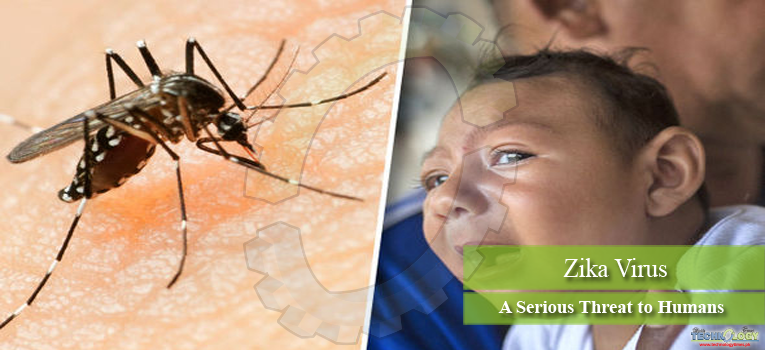Zika virus is a mosquito-borne re-emerging disease belongs to family flavivirus. The virus causes birth defects in babies born to some infected pregnant women, including microcephaly, where babies are born with underdeveloped heads and brain damage.

Zika has also been linked to Guillain-Barre syndrome, a condition in which the immune system attacks the nerves. It’s mainly spread through mosquitoes, although some cases of sexual transmission have been reported. It was first discovered in monkeys in Uganda in 1947.
It was later discovered in humans in Uganda and the United Republic of Tanzania in 1952. Zika virus disease has broken out in the Americas, Africa, and Asia. From the 1960s to the 1980s, rare cases of human infections were found in Africa and Asia, often accompanied by mild disease.
Signs and symptoms
The incubation period of Zika virus disease is about 3-14 days. Commonly, there are no sign and symptoms occur in people infected with Zika virus. Symptoms are usually mild to severe include conjunctivitis, fever, muscle and joint pain, rash, headache, and discomfort, usually lasting 2-7 days.
Complications of Zika virus disease
During pregnancy, Zika virus infection causes microcephaly and other congenital abnormalities in the fetus and newborn. Zika virus infection during pregnancy can also lead to pregnancy complications such as fetal loss, stillbirth and premature birth.
Zika virus infection is also a trigger for Guillain-Barré syndrome, neuropathy, and myelitis, especially in adults and older children. The effects of Zika virus infection on pregnancy outcomes, prevention, and control strategies, and the effects of infections on childhood and adult neurological diseases are currently being studied.
Transmission
Zika virus is mainly transmitted by mosquito bites infected by Aedes aegypti in tropical and subtropical regions. Aedes albopictus usually bites during the day and peaks in the early morning and evening/evening. This is a mosquito that spreads dengue fever, Chikungunya fever, and yellow fever. Zika virus is also transmitted from the mother to the fetus during pregnancy through sexual contact, blood transfusions and blood products, and organ transplants.
Diagnosis
It may be suspected that Zika virus infection is based on the symptoms of a person living or accessing a region with Zika virus transmission and/or Aedes mosquito carrier. The diagnosis of Zika virus infection can only be confirmed by laboratory tests of blood or other body fluids such as urine or semen.
PreventionMosquito bites
Anti-mosquito bites during the day and evening are key measures to prevent Zika virus infection. Special attention should be paid to the prevention of mosquito bites in pregnant women, women of childbearing age and young children.
Personal protective measures include wearing clothing that covers the body as much as possible (preferably light); using physical barriers such as window screens and closed doors and windows; applying insect repellent to skin containing DEET, IR3535 or icaridin according to product label instructions.
During pregnancy
During Spread pregnancy, Zika virus can spread from the mother to the fetus, resulting in microcephaly (less than normal head size) and other congenital malformations in infants, collectively known as congenital Zika syndrome.
Sexual transmission
Zika virus can spread through sexual intercourse. This is of concern due to the association between Zika virus infection and adverse pregnancy and fetal outcomes. For areas where the Zika’s virus is active, all people with Zika virus infection and their sexual partners (especially pregnant women) should receive information about the risk of Zika virus transmission.
Muhammad Nadeem, Muhammad Kasib Khan, Muhammad Shafi Hasni, Arslan Zafar, Zaheer Abbas
- Department of Parasitology, Faculty of Veterinary Science, University of Agriculture, Faisalabad, Pakistan